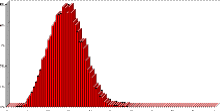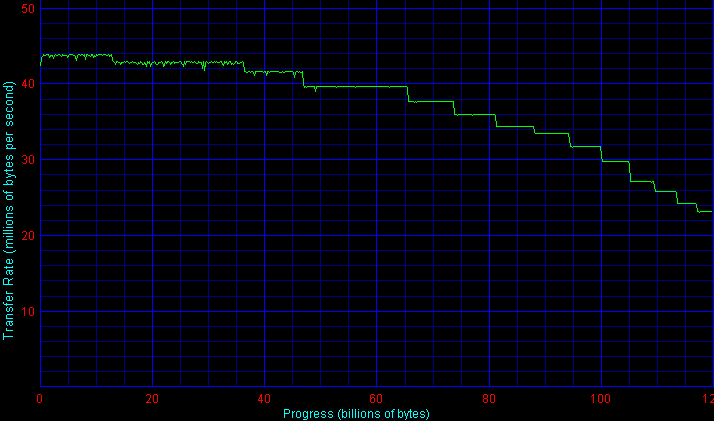The Barracuda ATA V is the first drive to hit the channels that incorporates the long-awaited Serial ATA interface. The SATA ‘Cuda is also the first ATA drive from Seagate to feature an 8-megabyte buffer. How does it rate? Let’s take a look!
|

To test Serial ATA drives, we have added a Promise SATA150 TX4, a four-port SATA controller to our testbed. The adapter’s bios and driver are initial release versions (v1.00.0.20 and v1.00.0.14 respectively). Promise also supplied us with a few SATA data cables as well as some adapters that convert a standard power supply’s Molex connectors to the new SATA edge connector standard.

Let’s see how Seagate’s latest measures up!
Low-Level ResultsFor diagnostic purposes only, StorageReview measures the following low-level parameters: Average Read Access Time– An average of 25,000 random accesses of a single sector each conducted through IPEAK SPT’s AnalyzeDisk suite. The high sample size permits a much more accurate reading than most typical benchmarks deliver and provides an excellent figure with which one may contrast the claimed access time (claimed seek time + the drive spindle speed’s average rotational latency) provided by manufacturers. WB99 Disk/Read Transfer Rate – Begin– The sequential transfer rate attained by the outermost zones in the hard disk. The figure typically represents the highest sustained transfer rate a drive delivers. WB99 Disk/Read Transfer Rate – End– The sequential transfer rate attained by the innermost zones in the hard disk. The figure typically represents the lowest sustained transfer rate a drive delivers. |
For more information, please click here.
|
Note: Scores on top are better. |
|
||

|
||
|---|---|---|
Seagate’s latest weighs in with a measured access time of 14.2 milliseconds. Subtracting 4.2 ms to account for the rotational latency of a 7200 RPM drive yields a measured seek time of 10.0 ms. Interestingly, despite its lower claimed specification, the SATA ‘Cuda V exhibits a higher seek time than its parallel brother. The drive misses its spec by one millisecond. This surprised us a bit as we’d expect an access time similar to the parallel version at the very least. We could not find a way to toggle the drive’s AAM settings, however. According to Seagate, these drives ship in performance mode. The firm graciously supplied a second evaluation unit just in case… both drives deliver a 14.2 ms random access time.
Unfortunately, the use of an external controller (the Promise SATA150 TX4) and its associated driver makes it difficult to consistently disable write caching which precludes us from presenting average write access times.
|
Note: Scores on top are better. |
|
|||||||||||||||
|
|
||||||||||||||
ST3120023AS Transfer Rate
|
|||||||||||||||
With an outer-zone score of 43.8 MB/sec and an inner-zone mark of 24.7 MB/sec, the SATA Barracuda turns in transfer rates identical to that of the PATA version. Despite its contemporary areal density, the drive lags significantly behind the competition from IBM and Western Digital.
Single-User PerformanceStorageReview uses the following tests to assess non-server use: StorageReview.com Office DriveMark 2002– A capture of 30 minutes of actual computer productivity use that exactingly recreates a typical office-style multitasking environment. The applications include: Outlook XP, Word XP, Excel XP, PowerPoint XP, Calypso (a freeware e-mail client), SecureCRT v3.3 (a telnet/SSH client), CuteFTP Pro v1.0 (an FTP/SSH client), ICQ 2000b), Palm Hotsync 4.0, Gravity 2.3 (a Usenet/newsgroups client), PaintShop Pro v7.0, Media Player v8 for the occasional MP3, and Internet Explorer 6.0. StorageReview.com High-End DriveMark 2002– A capture of VeriTest’s Content Creation Winstone 2001 suite. Applications include Adobe Photoshop v5.5, Adobe Premiere v5.1, Macromedia Director v8.0, Macromedia Dreamweaver v3.0, Netscape Navigator v4.73, and Sonic Foundry Sound Forge v4.5. Unlike typical productivity applications, high-end audio- and video- editing programs are run in a more serial and less multitasked manner. The High-End DriveMark includes significantly more sequential transfers and write (as opposed to read) operations. |
StorageReview.com Bootup DriveMark 2002– A capture of the rather unusual Windows XP bootup process. Windows XP’s boot procedure involves significantly different access patterns and queue depths than those found in other disk accesses. This test recreates Windows XP’s bootup from the initial bootstrap load all the way to initialization and loading of the following memory-resident utilities: Dimension4 (a time synchronizer), Norton Antivirus 2002 AutoProtect, Palm Hotsync v4.0, and ICQ 2000b.
StorageReview.com Gaming DriveMark 2002– A weighted average of the disk accesses featured in five popular PC games: Lionhead’s Black & White v1.1, Valve’s Half-Life: Counterstrike v1.3, Blizzard’s Diablo 2: Lord of Destruction v1.09b, Maxis’s The Sims: House Party v1.0, and Epic’s Unreal Tournament v4.36. Games, of course, are not multitasked- all five titles were run in a serial fashion featuring approximately half an hour of play time per game.
For more information, please click here.
|
Note: Scores on top are better. |
|
|||||||||||||||
|
|
||||||||||||||
|
|
||||||||||||||
The SATA Barracuda’s 8-megabyte buffer makes its presence felt in the StorageReview.com Office DriveMark 2002. At 366 I/Os per second, the ‘Cuda exhibits a 17% improvement over the PATA version. Despite the improvement, however, the SATA ‘Cuda nonetheless trails the Western Digital Caviar WD2000JB and IBM Deskstar 180GXP by significant margins.
This situation plays itself out through the High-End, Bootup, and Gaming DriveMarks. Despite scores that improve up to 25% over the PATA disk, the SATA ‘Cuda can’t quite keep up with WD’s and IBM’s drives.
Multi-User PerformanceStorageReview uses the following tests to assess server performance: StorageReview.com File Server DriveMark 2002– A mix of synthetically-created reads and writes through IOMeter that attempts to model the heavily random access that a dedicated file server experiences. Individual tests are run under loads with 1 I/O, 4 I/Os, 16 I/Os, and 64 I/Os outstanding. The Server DriveMark is a convenient at-a-glance figure derived from the weighted average of results obtained from the four different loads. StorageReview.com Web Server DriveMark 2002– A mix of synthetically-created reads through IOMeter that attempts to model the heavily random access that a dedicated web server experiences. Individual tests are run under loads with 1 I/O, 4 I/Os, 16 I/Os, and 64 I/Os outstanding. The Server DriveMark is a convenient at-a-glance figure derived from the weighted average of results obtained from the four different loads. For more information click here. |
|
Note: Scores on top are better. |
|
|||||||||||||||
|
|
||||||||||||||
Due to its higher access times, the SATA Barracuda stumbles a bit when contrasted with the PATA drive in totally random access designed to simulate typical server loads.
Legacy PerformanceeTesting Lab’s WinBench 99 Disk WinMark tests are benchmarks that attempt to measure desktop performance through a rather dated recording of high-level applications. Despite their age, the Disk WinMarks are somewhat of an industry standard. The following results serve only as a reference; SR does not factor them into final judgments and recommends that readers do the same. |
|
Note: Scores on top are better. |
|
|||||||||||||||
|
|
||||||||||||||
Heat and NoiseIdle Noise– The sound pressure emitted from a drive measured at a distance of 18 millimeters. The close-field measurement allows for increased resolution between drive sound pressures and eliminates interactions from outside environmental noise. Note that while the measurement is an A-weighted decibel score that weighs frequencies in proportion to human ear sensitivity, a low score does not necessarily predict whether or not a drive will exhibit a high-pitch whine that some may find intrusive. Conversely, a high score does not necessarily indicate that the drive exhibits an intrusive noise envelope. Net Drive Temperature– The highest temperature recorded from a 16-point sample of a drive’s top plate after it has been under heavy load for 80 minutes. The figures provided are net temperatures representing the difference between the measured drive temperature and ambient temperature. For more information, please click here. |
|
Note: Scores on top are better. |
|
||||||||||||||
|
|
|||||||||||||
The SATA Barracuda unfortunately will not power up without an active controller card attached, precluding us from conducting our standard objective noise measurements. Subjectively speaking, however, the drive unsurprisingly matches the noise floors turned in by the PATA ‘Cuda. It’s as quiet as they come these days.
At 20.2 degrees Celsius above ambient room temperature, the SATA Barracuda operates at expected heat levels. It’s a little bit on the warm side for an ATA drive yet should work well in any setup featuring adequate ventilation. The narrow width of the SATA cable itself should go a long way to ensuring better overall airflow in most cases.
ReliabilityThe StorageReview.com Reliability Survey aims to amalgamate individual reader experiences with various hard disks into a comprehensive warehouse of information from which meaningful results may be extracted. A multiple-layer filter sifts through collected data, silently omitting questionable results or results from questionable participants. A proprietary analysis engine then processes the qualified dataset. SR presents results to readers through a percentile ranking system. According to filtered and analyzed data collected from participating StorageReview.com readers, the |
According to filtered and analyzed data collected from participating StorageReview.com readers, a predecessor of the
Seagate Barracuda ATA V, the
Seagate Barracuda ATA IV
, is more reliable than of the other drives in the survey that meet a certain minimum floor of participation.
Note that the percentages in bold above may change as more information continues to be collected and analyzed. For more information, to input your experience with these and/or other drives, and to view comprehensive results, please visit the SR Drive Reliability Survey.
ConclusionThough it continues to deliver the legendary quiet operation that Seagate has become famous for, the Serial ATA Barracuda ATA V lags behind other top performance-oriented drives in both speed and capacity. Up until recently, the Barracudas were the only drive to plumb the depths of low noise operation. IBM’s Deskstar 180GXP, however, offers a similarly silent noise floor along with better performance. And, as has been the case for quite some time, nothing can touch the absolute performance delivered by Western Digital’s Caviar WD2000JB. To its credit, the SATA ‘Cuda V is the first drive to incorporate native SATA operation. So, if you’ve been dying to get your hands on an SATA drive and its accompanying narrow cable, this is the drive for you. Otherwise, you may want to spring for the competition or wait a bit to see how the upcoming Barracuda 7200.7 stacks up. |
